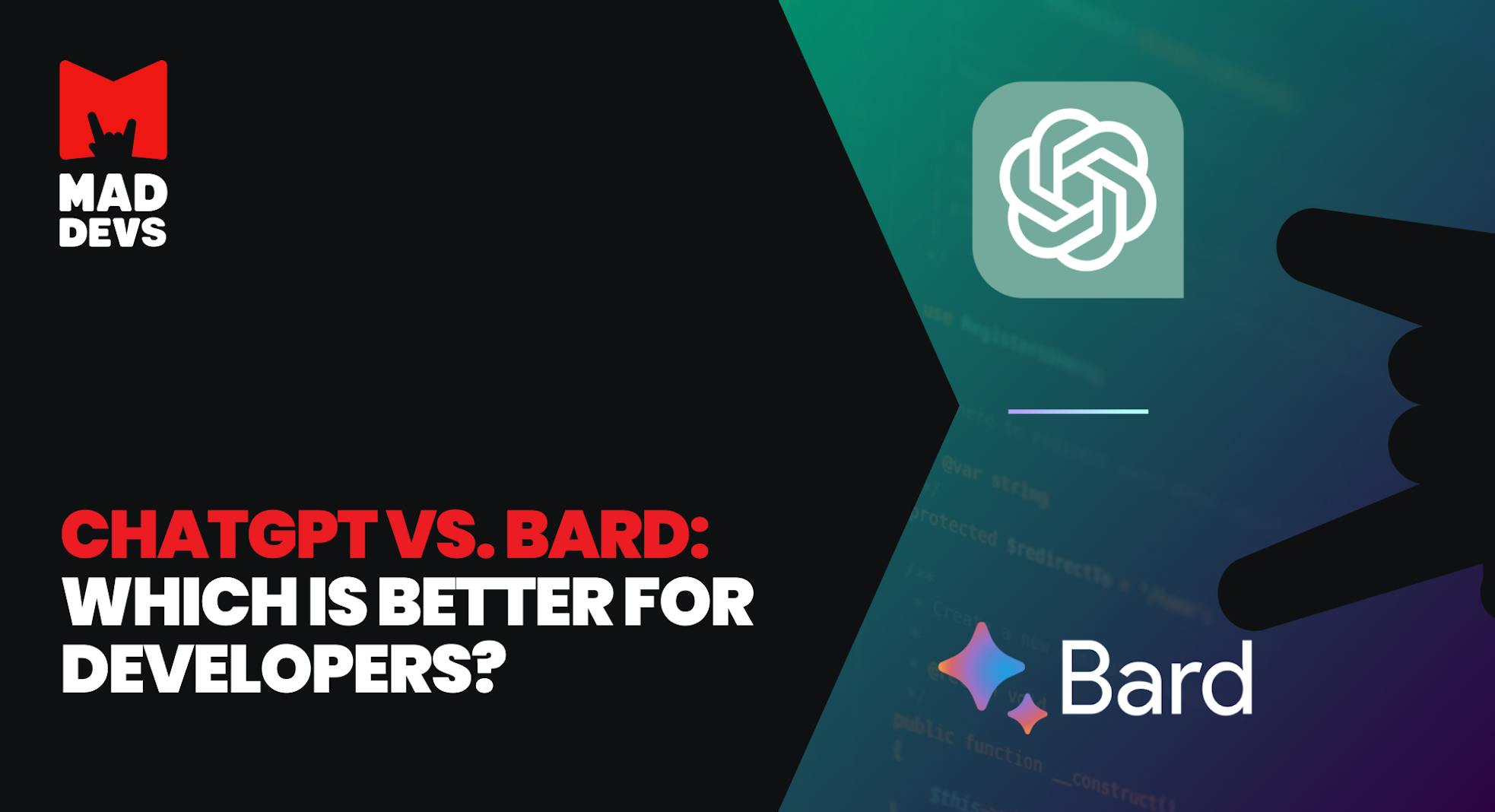In recent years, generative AI has emerged as a game-changer for programmers, ushering in a new era of possibilities in the coding world. By harnessing the capabilities of advanced language models, developers can now navigate the complexities of code writing and debugging with unprecedented ease. However, as competing tools like ChatGPT and Bard come into play, the question arises: which one reigns supreme for programming tasks?
This article delves deep into generative AI for programmers, exploring:
- What are ChatGPT and Bard, and how they help in coding
- What is the difference between these tools?
- Cases when these chatbots can be helpful
- What alternatives you can use?
We interviewed Mad Devs employees to gather diverse opinions about these tools. Don't miss the transformative journey as we unveil the power of generative AI and its impact on the programming landscape.
What are ChatGPT and Google Bard?
ChatGPT and Bard are designed to be accessible and helpful for everyone, but let's look at the perspective of programming. Whether you are a beginner just starting to learn coding or an experienced professional, you can benefit from these AI tools.
ChatGPT and Bard help beginners learn coding concepts, understand programming languages, and get assistance with coding challenges. They can act as helpful guides and resources to enhance skill acquisition.
Experienced developers can use them to streamline workflow, automate routine tasks, get quick answers to coding questions, and generate code snippets. These AI tools can save time and provide valuable insights, allowing developers to focus on more complex and creative aspects of their projects.
Regardless of your level of expertise, ChatGPT and Bard are versatile tools that can augment your coding experience and improve productivity. This makes them valuable assets for developers at all skill levels.
First, let's explore both tools' distinctive features and functionalities, examining how each contributes to generative AI advancement. Discover how AI-driven language models are shaping the future of communication and creativity.
ChatGPT

ChatGPT is an AI chatbot designed by OpenAI to assist people in various tasks and provide engaging and interactive conversations. Meanwhile, ChatGPT uses its Generative Pre-training Transformer 3 (GPT-3) or GPT-4 for paid subscribers. The premium version can also draw responses from Bing searches. It can assist users with scheduling appointments, answering general queries, or even providing conversational company.
Google Bard

Google Bard, an AI-powered chatbot, utilizes natural language processing and machine learning to mimic human conversations and generate responses from the Internet. Initially, Bard employed LaMDA for dialogues, but it has now transitioned to Google's advanced language model, PaLM 2 (Pathways Language Model).
According to Google, PaLM 2 excels in common sense reasoning, logic, and mathematics compared to its predecessors. The primary objective of Bard is to provide concise answers to users rather than displaying a traditional search engine results page with links that lead to additional information.
Comparative look at chatbots' flexibility and customization
Both chatbots are AI-powered to provide interactive and customizable use experiences. However, they offer flexibility and customization to varying degrees.
- ChatGPT
ChatGPT is known for its versatility and flexibility. It can handle a wide range of tasks, especially code-related. ChatGPT can be customized to adapt its behavior to specific use cases, improving its performance in various domains. It doesn't have a built-in mechanism for direct customization but can be fine-tuned with additional data training. - Google Bard
Google Bard is touted as a customizable chatbot. Its features allow users to fine-tune the generated content's style, tone, and specificity, not the code-related queries.
Both chatbots strive to provide customizable conversational experiences, but the extent of customization available and use areas may differ. It's important to consult their respective documentation or official sources for the latest information on their customization capabilities, as updates and improvements are continuously made to these models.
Differences between ChatGPT and Google Bard
ChatGPT and Bard offer comparable services, where users input queries and receive responses. As a developer, you may face the challenge of selecting the most suitable tool.
| ChatGPT | Google Bard | |
|---|---|---|
| Language model | GPT-3, GPT-4 (paid) | PaLM2 |
| Source of information | Data free | Internet |
| Information cutoff | 2021 | None |
| Access | Unlimited | Limited |
| Pricing | ChatGPT is free, ChatGPT Plus is $20/month | Free |
The key distinction between ChatGPT and Bard lies in their data sources. While Bard continuously retrieves information from the Internet, ensuring access to the latest data, ChatGPT's sources are limited to data up to 2021, resulting in potential limitations on newer research and information.
Apart from disparities in data sources and language models, there are a few other significant differences.
- Coding. ChatGPT has been used for a while to generate code, whereas Bard has fewer capabilities in this area. Sometimes Bard creates code that doesn’t run.
- Learning. While ChatGPT can learn from its conversations with people and "hold context," Bard has some limitations.
- Drafts. By pressing "View Drafts," Bard will produce multiple responses to your queries. ChatGPT will only make a single response, so you always need to request a new one.
- Limited context. Users have raised concerns about ChatGPT and Bard's capability to maintain context in longer conversations. They may forget previously provided information, leading to contradictory responses.
- Generic responses. According to some users, both language models repeat boilerplate responses regardless of the context, which leads to redundancy.
Generally, both AI-powered chatbot models have access to vast information sources. Both models offer valuable language understanding and user experiences, although they employ distinct training methods and information access.
Use cases of ChatGPT and Bard in coding
In the world of coding, ChatGPT and Bard stand out as powerful AI tools that have revolutionized how developers approach their projects. Through our experiences and testimonials, we delve into the diverse applications of these tools in different coding scenarios and showcase how they simplify tasks and enhance productivity for developers worldwide.
Project planning. ChatGPT and Bard can assist in project planning and task management, helping developers organize their coding projects effectively. For example, Google Bard can be useful for brainstorming ideas for projects, products, and marketing campaigns. While Bard's project planning features are limited, it can be a beneficial tool for organizing and structuring coding projects. ChatGPT also proves itself helpful in project planning in suggestions, generating ideas, and aiding in tasks like data analysis, model selection, and code optimization.
Code assistance. ChatGPT and Bard can help developers with code-related queries, providing suggestions and solutions for coding challenges.
There are times when I need to work with SQL scripts. I encounter them relatively infrequently, so I might forget certain things. ChatGPT occasionally helps me when encountering difficulties.
Documentation. ChatGPT and Bard can aid in writing technical documentation, helping developers explain their code and projects more effectively.
Code generation. They can assist in generating code snippets for specific tasks, and save developers time and effort in writing repetitive code. Following a recent update, Bard is now equipped with features to assist with programming and software development tasks, including code generation in languages like C++, Go, Java, JavaScript, Python, and TypeScript. But it's important to note that Bard is not specifically designed or optimized for programming tasks like coding or software development.
I turn to the chat for help when I need to write blocks of code. For instance, I can provide ChatGPT with a JSON data structure and request a function that reformats the data into the required format. This speeds up the workflow, and I don't have to spend time figuring it out on my own.
Automation. ChatGPT can be integrated into automated workflows, streamlining repetitive coding tasks. Integrating ChatGPT into Microsoft Word, Excel, and Outlook has recently become possible. Bard is suitable for automating tasks within Google Sheets, automating data entry, and population. Moreover, it assists in generating code snippets, optimizing code, writing functions for Google Sheets, and enhancing automation to improve coding workflows.
Code reviews. These AI tools can analyze code and offer insights, making the code review process more efficient and thorough.
Sometimes I can't keep up, forget, or miss where and what parameters are accepted 'here,' what comes next, and so on. Now, I can hand over some of the code, ask ChatGPT to write comments, and I will get excellent results.
Both chatbots have emerged as indispensable companions for developers in their coding journey. These AI tools have proven their worth in diverse coding tasks, from providing code suggestions to generating snippets and streamlining automation. As developers continue exploring and integrating their capabilities into their workflows, ChatGPT and Bard will continue to transform coding processes, offer innovation, and increase efficiency and success in the ever-evolving tech landscape.
ChatGPT third-party plugins & UI extensions
NB, there are currently no plugins for Google Bard. While there have been rumors about its inclusion in the roadmap, no specific timeframe has been confirmed. We will follow the news and update the article as soon as any plugins and extensions appear.
ChatGPT offers the possibility of third-party plugins and UI extensions, allowing developers to extend the functionality and customize the user interface according to their specific needs. These customizable tools enable tailored solutions and smooth integration into applications.
ChatGPT
Since gaining public attention, ChatGPT has experienced an immense surge in popularity. OpenAI's chatbot launched in November 2022, and it has become so renowned that server capacity is under strain. If you need such tools, you can search the Internet and find over 500 ChatGPT Chrome extensions.
With this number of plugins available, it can take time to choose the right one. Here are some tips for finding the right plugin:
- Assess your requirements. Determine the desired functionalities of the plugin, such as code generation and editing, the ability to search through GitHub, or creating a plugin library.
- Review plugin descriptions. Read carefully to understand what each plugin offers and how it exactly works to ensure it aligns with your needs.
- Check user reviews. Evaluate feedback from other users to gauge the plugin's performance and suitability.
- Test the plugin. Utilize ChatGPT's free trial to experiment with different plugins and make an informed decision based on your experience.
After identifying several plugins of interest, compare them to determine the most suitable one. Evaluate the features, reviews, and ratings to make an informed choice. Additionally, try out the plugins firsthand to discover your preferred option.
To make your life easier, we've listed popular plugins that you may find useful.
There is an AI for That

Introducing There is an AI for That — an AI plugin for developers, making finding the right tools effortless. You will have access to 700+ AIs across 100 categories to optimize productivity. No more wasted time searching because you can find what you require with just a few clicks.
ChatWithGit

ChatWithGit is a newcomer to the ChatGPT store, simplifying GitHub code search. Save time and avoid reinventing the wheel with code snippets and repository links.
Link Reader

Link Reader is an advanced tool that interprets content from various digital resources, providing accurate and relevant responses. It facilitates tasks like summarizing articles and analyzing reports. Please note that it respects copyright and privacy laws.
Wolfram Alpha

The Wolfram plugin improves ChatGPT's math capabilities by granting access to computation, curated knowledge, and real-time data from Wolfram Alpha and the Wolfram language.
Code Interpreter
Although currently in closed alpha, this plugin is an exciting addition to the library. It allows running Python code within ChatGPT, enabling file uploads, code adjustments, and ChatGPT's suggestions. Users are leveraging it to collate vast datasets and even create visualizations. For example, one user created a map of lighthouse locations from a CSV with a single prompt.
Alternative AIs for coding
As the demand for efficient coding solutions continues to rise, AI-powered coding assistants have emerged as invaluable tools for developers. In this section, we explore some alternative AI coding assistants that cater to various coding needs, offering real-time code recommendations, static code analysis, and intelligent code completions. These tools are designed to streamline developers' workflows, improve code quality, and boost productivity, making them essential assets for coding endeavors.
Sourcegraph Cody

Sourcegraph Cody is an AI-powered coding assistant that enhances your coding workflow and deepens your understanding of codebases. Sourcegraph's primary product is a code base assistant, allowing you to search across repositories, branches, and code hosts to locate code and track updates. Leveraging Sourcegraph's code graph and LLM, Cody delivers context-aware responses, aiding in code discovery, function creation, and debugging. Whether you need precise code generation or code explanations, Cody interprets your natural language instructions, making coding more efficient and accessible, regardless of your experience level.
Key features:
- Swiftly finding code by function name, file name, or plain descriptions in English.
- Creating code snippets or full functions guided by your instructions.
- Simplifying complex code structures or functions through clear explanations.
- Detecting and assisting in resolving bugs within your codebase.
Pricing: Cody is free for individual users, and there are enterprise plans available.
Amazon CodeWhisperer

Amazon CodeWhisperer is an AI-powered code generator that offers real-time code recommendations within developers' IDEs. Trained on extensive open-source code data, it suggests snippets or full functions based on comments and existing code. Supporting multiple programming languages and IDEs like JetBrains and Visual Studio Code, CodeWhisperer enhances productivity, automates repetitive tasks, and ensures precise and secure coding following industry standards. It's a valuable tool for developers seeking efficiency, accuracy, and security in their coding workflows.
Key features:
- Real-time code recommendations in various programming languages.
- Compatibility with multiple Integrated Development Environments (IDEs).
- Reference tracking and security scans.
- Machine learning-powered suggestions to improve code accuracy and security.
Pricing: Free for individuals with paid plans starting at $19/month.
GitHub Copilot

GitHub Copilot stands out as a top-notch AI coding assistant, revolutionizing code creation for developers. Powered by the OpenAI Codex language model and drawing from a vast repository of public code, Copilot offers comprehensive assistance, suggesting lines of code, completing functions, writing comments, and aiding in debugging and security assessments. It is a powerful tool that empowers developers to craft high-quality code more efficiently and accurately.
Key features:
- Seamless integration with popular IDEs like Visual Studio, Visual Studio Code, Neovim, and JetBrains.
- Code suggestions, including entire functions, while writing code.
- Cycle through multiple auto-complete options with ease.
- Identify and fix code errors.
- Detect potential security vulnerabilities in your code.
- Generate informative comments for better code understanding.
Pricing: Free plan available for individual devs and paid plans starting at only $4/month.
Codiga

Codiga is an AI-driven static code analysis tool designed to enhance code quality, speed, and security for developers. Leveraging artificial intelligence, Codiga meticulously examines code to detect potential errors, vulnerabilities, and other concerns. It seamlessly integrates with popular development environments, including VS Code, JetBrains, VisualStudio, GitHub, GitLab, and Bitbucket.
Key features:
- Utilizing static code analysis to identify errors and implement early fixes.
- Automating code reviews for time-saving and enhanced code quality.
- Accessing code snippets for common tasks, improving overall efficiency.
Pricing: Free plan available with paid plans starting at $14/month.
Tabnine

Tabnine is an AI-powered coding assistant that enhances developer productivity through swift and efficient code writing. Supporting multiple programming languages such as Python, Java, JavaScript, PHP, Go, and Rust, TabNine's neural network learns from an extensive open-source code dataset, enabling precise and smart code completions, even in intricate coding scenarios. With intelligent completion suggestions and error identification, Tabnine boosts productivity, improves code quality, and reduces expenses, making it a vital tool for developers.
Key features:
- Intelligent code completions based on a massive dataset of open-source code.
- Code linting feature to identify and suggest fixes for potential errors.
- Code refactoring assistance to enhance readability, efficiency, and maintainability.
- Automatic generation of code documentation for better understanding and collaboration.
Pricing: Free plan available for individuals with paid plans starting at $15/month.
The world of coding is rapidly evolving, and AI-powered coding assistants have proven to be transformative for developers. These alternative AI solutions are revolutionizing how developers write code, from real-time code recommendations to static code analysis and intelligent completions. Whether it's enhancing efficiency, improving code quality, or ensuring code security, these tools offer diverse features to cater to developers of all levels.
Conclusion
Both language models offer remarkable capabilities for developers. As we can see, ChatGPT stands out with its user-friendly interface, natural language processing abilities, and extensive third-party plugins, making it a valuable choice for various coding tasks. At the same time, Google Bard shines with its language generation and translation capabilities, as well as its potential integration with other Google services, but not so popular among developers. You must consider your specific needs and preferences to determine which tool best aligns with your projects. As the field of Generative AI continues to evolve, these language models promise to revolutionize the programming landscape and open up endless possibilities for developers worldwide.









